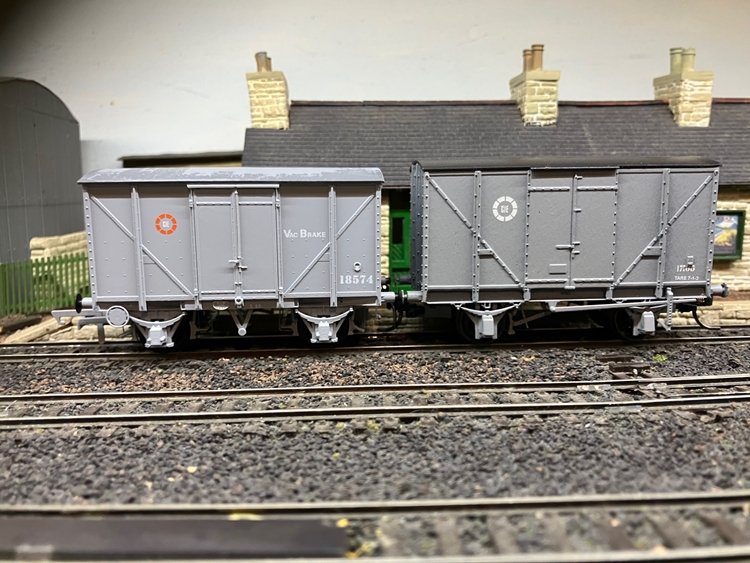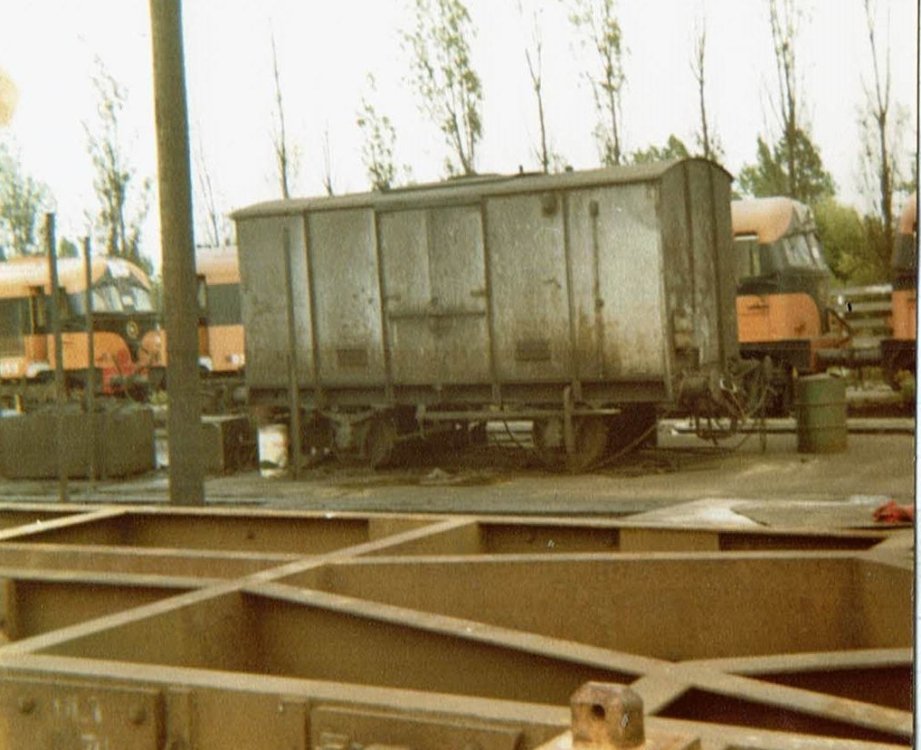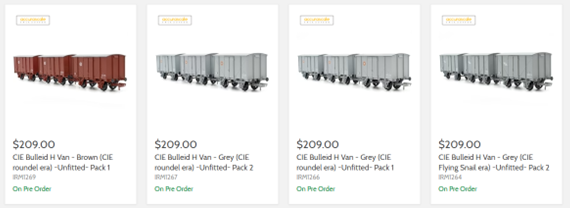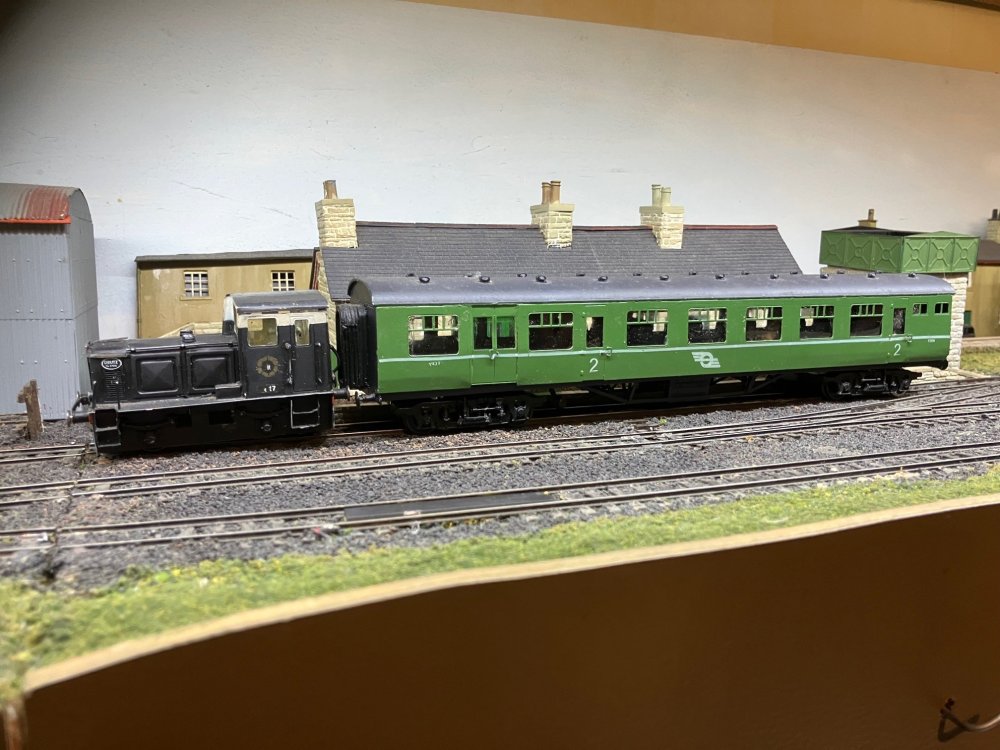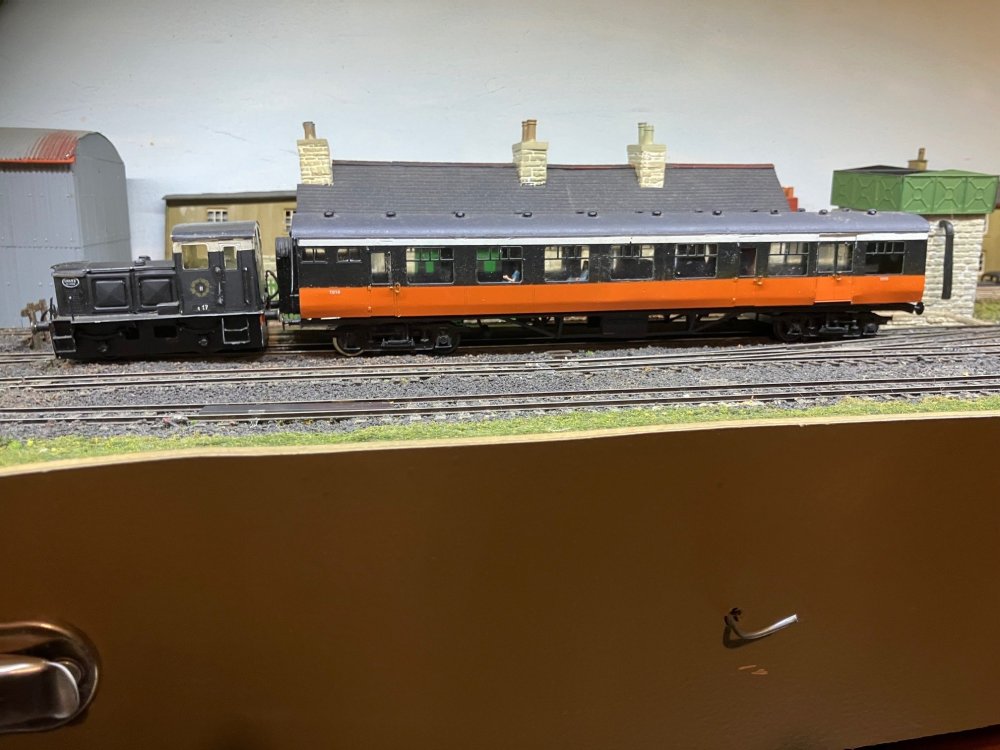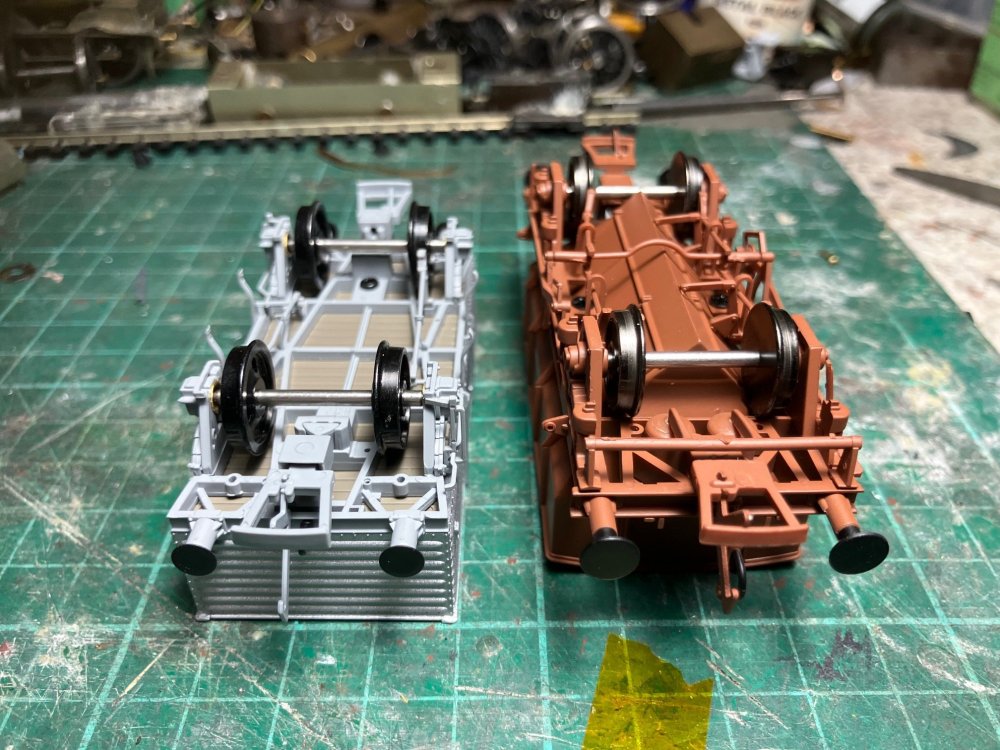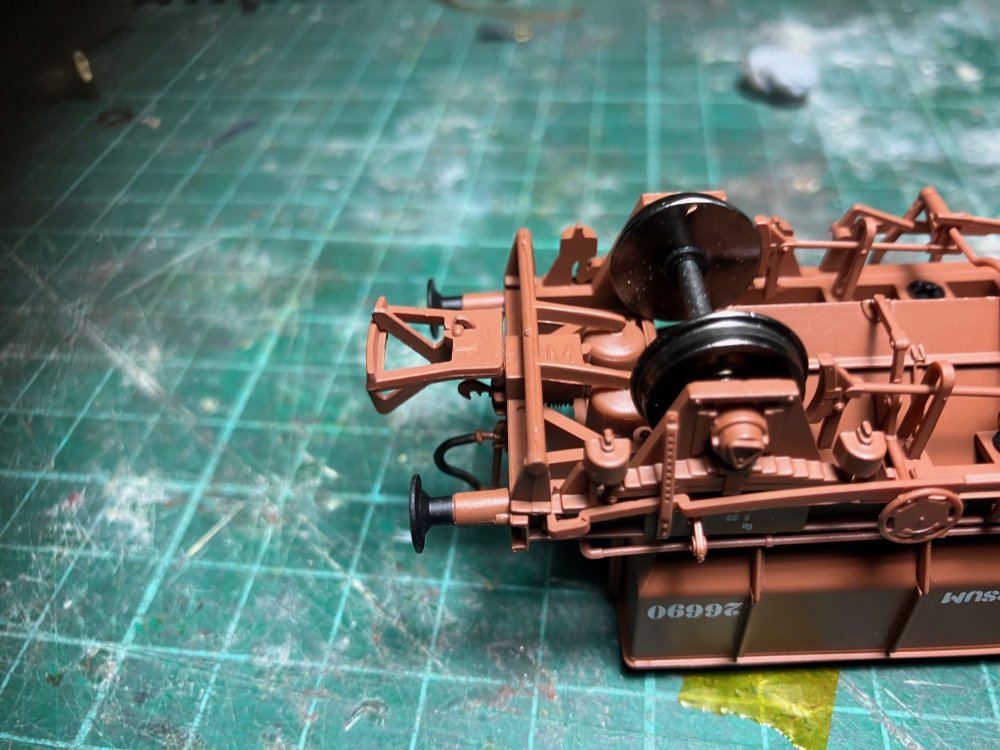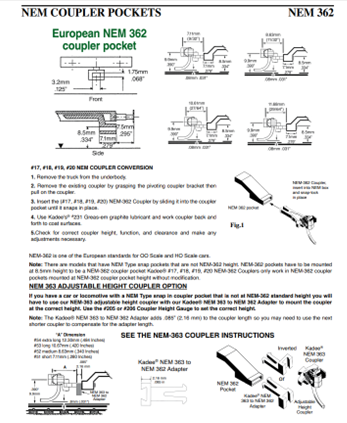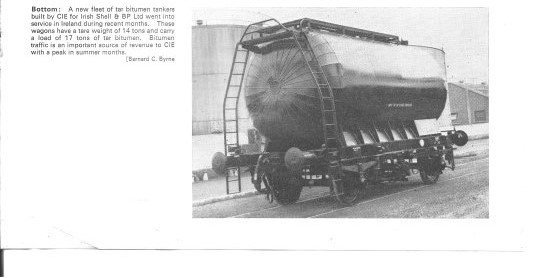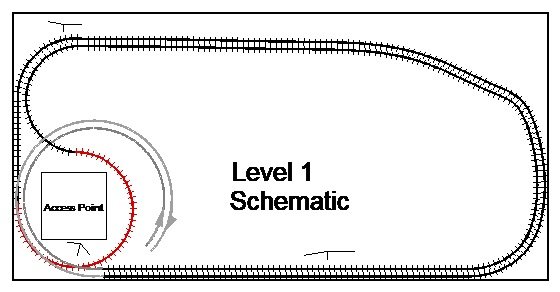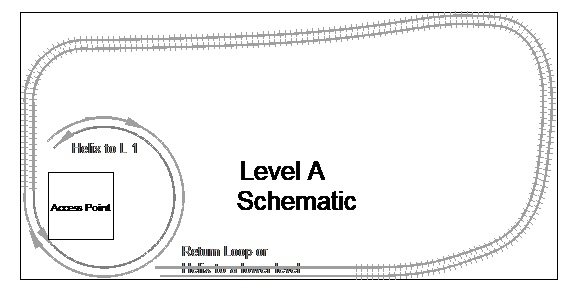-
Posts
4,873 -
Joined
-
Last visited
-
Days Won
119
Content Type
Profiles
Forums
Events
Gallery
Everything posted by Mayner
-
Although similar in appearance to the Bulleid H Vans the 200 1946 vans were quite different in construction basically an updated 10' wb version of the GSWR vans introduced in 1917 with the timber planking obscured with sheet aluminim cladding. CIE re-skinned some older vans with sheet aluminium cladding including the 1917 'standard' design, some of the older longer GSWR "Big Boy" vans & even some ex-GNR. There is a photo of one of these vans under construction in the Inchacore 150 Book "The Works". Aluminium over planking may have been a post WW11 econmy measure, plentifull supply of aluminium (intended for aircraft production) combined with a scarcity of quality hardwood available for wagon building. GNR coaches built during the same era tended to have hardboard or "Masonite" body cladding on softwood framing which later lead to decay and scrappping. Comparison of an IRM 'Fitted" Van and one of my 1946 Vans. Mine based on a Herbert Richards drawing of a 1946 van appears larger by the IRM model the 1917 GSWR vans appear taller than the Bulleid Vans in photo of the prototype. I guess its time to think about 'retiring' my collection of 21mm gauge H Vans modified from the Parkside Van kit about 30 years ago & some GSWR Vans modified from Coopercraft GWR Van kits around the same era.
-
The challenge for a rtr or kit manufacturer is to sell enough of a particular model to make it worthwhile in a competitive price. Thus IRMs focus on selling multi packs of almost identical wagons and earlier focus on 'modern' block train wagons like the Ballast & Cement wagons where the average customer might buy 10 or 20 rather than an individual wagon. While JHB pointed out that the average traditional goods train could have 34 wagons, well 50-5 max on the Cork line or Midland, it was likely to have only one goods brake or possibly a second if the train reversed or divided in route. So potentially a retailer selling 1 Brake for every 10 H Vans or Opens sold, so in the Irish outline market a Brake Van would struggle to reach 2500-3000 to break even let alone a profit. Personally I suspect a lot of buyers of RTR models(and kits for that matter) are collectors who have no real interest in running models let alone prototypical accuracy, after-all how else can you explain a person buying 12 different versions of the same locomotive, or the surge of sales on e-bay soon after a model goes on the market or sells out. Interestingly many years ago when I had a large American outline N gauge, visiting operators quickly got bored with prototypical operation and loved to literally race trains around the layout at the end of a formal operating session, the challenge was to keep two trains (15-20 car freights) running as fast as possible continuously run layout with mixture of fairly long (15-20') single and double track sections (without stopping) I am as guilty as anyone else I have a large collection of N and 4mm models in display cases around the house and boxes of IRM and MM models that I have never run and at this stage getting less likely to run.
-
Recently I had suggestion from within Accurascale that it would be a good time to do a small repeat run of my 20T Brake Van.
-
G601-3 were acquired as part of an experiment to operate goods trains on the Banagher, Newmarket and Castleisland branches on which regular services ceased during the 1947 fuel crisis. G601 survives with the ITG https://www.irishtractiongroup.com/loco/g601 members who have worked on the loco should have information on the braking system. I measured up the loco at Carrick before the cab and engine housing was encased in metal cladding. Apart from 3 link couplings, no train brake and different cab windows the arrangement of shunter's steps and running plate at the front of the loco is different between the G601 & G611 Class. One G611 Class duty was Liffey Junction Pilot which included a weekly? Edenderry goods working and occasional goods trains on the Meath Road after Clonsilla-Navan closed to regular traffic (62 or 63) The final goods working over the southern section of the Meath Line was a Liffey Junction-Drumree Cattle Special with special permission to load to 15 wagons, nothing heavier than a G allowed because of the poor state of the track! The G ran to Kilmessan to recover a single wagon after placing the cattle wagons at Drumree. Apparently the rails on the cattle bank sidings at Drumree were grass grown the G struggled to achieve traction and some teens from local farms helped by push the loco and laden wagons out onto the 'main line' There is an account of the story by 'Spare Link' in one of the Great Southern Preservation Society newsletters of the 80s
-
Visited the Manifold Valley several times 25-30 years ago while railfanning in the Peak's. I think the loco shed was part of a Council road depot 1st time I visited Hume End, but a miniature possibly 3"½' gauge was set up at the Waterhouse end of the carpark leading back a hundred or so yards on the trackbed, being me it was late afternoon/evening & no one was around. Yes drove several times through the tunnel and last time I was over cycled from Waterhouse to Thors Cave. Although close to the cities of Stoke and Greater Manchester the Manifold Valley is remote largely accessible by the Manifold Trail probably one of the first of Britain's rail to walking/cycling trail. This was well before the days of the re-opening of the Cauldon Low Branch as a heritage railway, although out of use the semaphore signalling system at Leekbrook Junction and the yard and ground frame at Cauldon Low intact.
-
The Cultra Van is a bit of an odd-bod an all metal body on a GSWR underframe possibly a one off once used to house (steam cleaning?) plant off rail in the Ramps area of Inchacore. I must be beginning to get old took the photo almost 50 years ago. On the Brake Van question all CIE goods trains Fitted, Unfitted or Partially fitted which included traditional wagons like H Vans would have run with a Brake Van. The North Wall-Waterside "Derry Vacuum" was officially a fully fitted goods hauled by a CIE loco to & from Lisburn with MPD or 70 Class working the train to and from Waterside, though one of Jonathan Allen's photos shows an MPD Power car shunting unfitted H Vans at Waterside. On trains like the mails a number of Fitted wagons were allowed run behind the Coaching stock, I have a photo of an Up Sligo mail approaching Ballysodare behind B149 the train made up of a 4W Tin Van (Heating & Luggage) in Black and Tan, what looks like an ex-GSWR side Corridor coach in late 50s Green, a Bogie TPO possibly ex-GSWRin light green & 3-4 H Vans. Initially Block Trains of Cement Bubbles ran with a Goods Brake Van before CIE & the Unions agreed for the Guard to ride on the loco, riding in a Brake Van at 50mph at the rear of a goods train would not have been a comfortable or safe working environment. The CIE 20T Brake Van introduced in the 50s would have been preferred over the 30T Vans introduced in 1960s which had a problem of running hot boxes (overheated bearings) until later fitted with roller bearings, the unlined( uninsulated) all steel interior would have been an uncomfortable working environment too cold in winter, too hot in summer likely to have been avoided by staff unless nothing else was available. Possibly a Taranaki thing; pricing appears in $NZ in the Waikato even without logging in, though a US Shopify site thought I was in South Africa and displayed prices in Rand.
-
One of the supreme ironies with the current situation is that American experts (Demming, Durand et-al) pioneered the concepts that allowed American businesses to offshore their manufacturing the Far East and China. Ironically these experts were largely ignored in the US but taken seriously by the Japanese during the post World War re-build, at the time it was probably thought that the World would be safer if the Japanese (and other defeated axis powers focused their energies) on manufacturing motorbikes cars and radios. I was once sat in the canteen of a major Ford dealership in Dublin during the 80s and one of the managers questioned who really won the War pointing to the nearly Audi-Volkswagen and Nissan plants. Ironically these methods were adapted by the US Navy in the 1980s rebranded as Total Quality Management or TQM. JIT was basically using subcontractors to manufacture the components for delivery to the assembly plant just in time, classically in Japanese mini vans. Atlas is an interesting one shifting (loco) production to Italy (Rivarrosi) 70-80s, Austria (Roco) 70-80s Kato (Japan) during the 80s and China mid 90s. A similar lower priced Model-Power range was produced in Yugoslavia but does not appear to have survived the break up and civil war. The N scale Con-Cor PA1 & Atlas N Scale RS3 both manufactured by Kato were transformative in terms of detail finish and running (center motor twin bogie drive) the running of the Kato locos best described as impeccable, Atlas 90s Chinese production was even more refined in finish with extremely smooth low speed running but sounded like a tractor, their early 2000s era Chinese production was utterly transformative. Interestingly Trump is already being portrayed as the Grinch in the US Media https://www.usatoday.com/story/news/politics/2025/04/30/trump-china-tariffs-toys/83372961007/ , my wife and her mum (staunch Democrats) from the Mid-West religiously watch the Boris Karloff version of the Grinch on Christmas Day
-
China has been stressing that the US market makes up about 15% of its total export market and so could potentially compensate by increasing exports to the rest of the World, China has no hang ups about subsidising exports to other countries. Interestingly imports from China make up about 16% of US imports. Imports are prodimently Hi Tech most likely assembled on automated production lines so unlikely to be an army of redundant workers to divert to 'defence' China has been very effective of expanding its influence using soft power to finance and build infrastructure in the Global South and Pacific and has caught The United States, Australia and New Zealand off guard by successfully negoting agreements with Pacific Island Nations in what was presumed to be their 'sphere of influence" China and Japan has an advantage over Europeans due to the similarity in culture and way of doing business with Pacific Island nations. The Chinese pissed off Australia recently by conducting live firing naval exercise in the Tasman Ocean of the East Coast but more a posturing exercise than anything having already signed a 'Strategic Partnership Agreement" with the Solomon Islands which includes security and law enforcement, together with China owning some of Australia's ports. The real cost of on-shoring clothing, engineering and toy manufacturing to Western countries would be a singificant increase in the cost of living and decline in living standards in the West, East South East, Asia and India and most likely a dramatic increase in poverty and malnutrition in the Global South. Unfortunately the United States is slipping towards totalitariansim lead by a bunch of grifters that would make teach the average African Kleptocrat a lesson or two about lining their own pockets.
-
Recent delivery advice from Accucraft that they are honouring the pre-sale price of $2500 for the 1:20.3 scale live steam Australian "Puffing Billy' 2-6-2T to US Customers regardless of recent tariffs. April 23rd, 2025 Accucraft Victorian Railway NA Class, Baldwin 2-6-2T We are pleased to inform you that the Puffing Billy is finally ready to be shipped! Thank you for your continued interest in Accucraft products and for your patience throughout the process. The model is absolutely gorgeous, with exceptional attention to detail and finishing. Our team have done a wonderful job producing one of the finest models we've ever offered. We are also happy to inform you that, despite the recent tariffs, we are honoring the pre-sale price until the May 2nd. Accuracraft is a US owned business with its own factories in China More Information Subscribe to our Youtube Channel Accucraft reserves the right to change prices, colors, specifications and availability without notice. All items are FOB Union City, CA unless otherwise stated. Live Steam Station 33260 Central Ave, Union City, CA 94587 510-324-3399 • sales@accucraft.com Interestingly while I was staying with family in North Dakota during January the Canadian Pacific was loading a 100 Car Train with grain for China at one of the local elevators. A farmer told me that most of his grain goes to the Far East and the US Government will buy his surplus production if he cannot find a buyer on the open market, a Trade War could work out more damaging to the US than China.
-
Having produced kits and rtr models for 15 years with marketing through social media, website and New Irish lines. Sales of kits have been primarily been to a group of regular UK based customers by social media (mainly this Newsgroup). I suspect the majority are attracted to Irish Outline because its considered more interesting and challenging that modelling British Outline. The majority of RTR sales were through my website, this Newgroup the most effective in terms of marketing. One of the quirks was that samples supplied to model railway clubs generated few sales, a member of one club commented that he 'could not see the point' of buying an Irish outline wagon while plenty of British RTR wagons were available at a lower price. Interestingly used to get occasional enquiries on Facebook usually from the States requesting a valuation claiming that they had JM Design model trains from their childhood Demographic wise RTR sales broke down fairly evenly between Ireland & the UK----respectively 45% & 40% with 15% from USA with rest of the World marginal. While Irish and UK customers tended to buy 1 or 2 items, US customers consistently tended to place larger orders. When all is said and done Irish Outline is a tiny compared with the British and American outline markets and the IRM founders strategy of testing and establishing a presence in the UK market allows Accurascale to produce Irish Outline models. From small beginnings Irish owned multinationals have become world leaders in building materials (Roadstone) dairy and food (Glanbia and Kerry) engineering consultancy (MF Kent) Construction (Laing O'Rourke) so why not model railways?
- 34 replies
-
- 11
-

-

-
Great to hear that your Knockloughrim diorama has found a (hopefully permanent) home in the actual station.
-
Ex-GNR (express passenger) locos are likely to have been used on the 'Trial Train' (newly overhauled coaches) between Inchacore and Portarlington up to the end of steam on CIE or sold to the UTA. So potentially a legitimate reason for running an S Class, Compound & Vs at speed other than an enthusiasts special on the GSWR main line
-
I was an NMRA (National Model Railroad Association) British Region member when I lived in England during the 80s & 90s, the British Region organised an Annual Convention and was divided into groups that organised local 'Meets' at regional level in the UK. The Meets and Conventions were basically private exhibitions often featuring modular layouts where members could bring and run their own stock (play trains), and a swap meet which included specialist American Outline retailers and second hand stands, the retail side usually best described as a feeding frenzy. At the time Victors (Islington) & MG Sharp (Sheffield) were major retailers, LSWR models a major mail order supplier, Totally Trains (Ross & on Wye) and Mac's Models (Alexandria nr Dunbarton),relative newcomers in the American Modelling the scene, not forgetting the Belfast Caboose and an American Outline retailer in Bodmin (Cornwall) & possibly others I have forgotten Back in the 80s American Outline models N & HO models tended to be of better quality than British outline models in terms of finish, detail and smooth running major American brands like Atlas & Walthers moved their production from the US to Europe and eventually the Far East. The majority of American locos ran reliably out of the box and the major brands adapted NMRA wheel and track standards as there was a fundamental expectation among American outline modellers, that the different brands of locos and stock should 'interchange' reliably just like the prototype. Going back to Scandinavian models, I hooked up with a lady of Scandinavian-Germanic origin over 20 years ago. Best described as strong minded put manners on most Irish lads, though most Irish and British people have some Scandinavian-Germanic DNA given the antics of our ancestors 1000 or so years ago.
-
I guess 10 years after the launching of IRM the founders of IRM and Accurascale understand the limitations of the Irish Outline market and whether or not it was worthwhile to market Irish outline models on the UK Exhibition circuit. There is an interesting contrast between the rapid expansion of Accurascale from a start-up to a major British Outline brand over the past 4-5 years with a mixture of modern image, steam era and industrial models (locos and stock) compared with the more gradual expansion of the IRM range following the initial period of rapid expansion up to the release of the 001/A Class. Interestingly while there were 93 and 96 responses to IRMs launch of the NIR Hunslets & GSR/CIE 800s respectively there are currently 1900 and 9800 replies currently to launch of the Accurascale BR Class 50 & Class 37. One of the IRM founders commented that their British Outline loco or wagon sold in significantly higher quantities than a similar Irish Outline model, possibly a 5-1 ratio, around 2020-21 Patrick told me that demand for Accurascale their British Outline wagons made IRM look like a cottage industry.
-
In the post 1960s era the three largest groups of Private Owner wagons to run in Ireland would have been the ESSO Tank wagons 971-1013 imported from the UK in the late 60s, Tara Mines ore wagons 31001-31025 & NET Ammonia Tank 32001-32020 wagons leased from Storage and Transportation Systems (STS)London There were also a number of CIE owned Branded wagons introduced during the 70s, Burmah Oil Tank Wagons 26723-26728, Pallet Cement Wagons 28001-28172. While IRM have released a model of the ESSO 35T tank wagon it is of the unbranded version of the wagon with modified tank mounts and hazard markings, rather that the original version introduced in the late 60s with original pattern tank mounts and raised ESSO shield and logo https://www.flickr.com/photos/irishrailwayarchive/53527716615/in/album-72157661623942928. For people without access to the IRRS Flickr album the ESSO Teo tank wagons were visually similar to the UK Class A tank wagon with ESSO shield and simplified markings/lettering. IRM have already released the Tara wagons in their original blue livery witt Tara logo. Whatever about the Ammonia and Burmah tank wagons, the Pallet Cement Wagons appear to be a significant gap in RTR wagons for the late 70s early 2000s era with the original version with Irish Cement logo and balanced doors, and later unbranded versions with balanced doors and curtain sides. For the modeller with a main line oval layout in a restricted space the Tara Mines and Ammonia Tanks short train behind a 001 Class entirely prototypical. Going back to the County Down a series of papers on BCDR private owner wagons was published (Des Cookham?) was published in the IRRS journal in the late 60s early 70s, apart from the East Downshire the common thread was the use of private owner wagons to transport stone to Belfast during the 19th Century, a "Dr Richie" was one of the major quarry owners. The Dublin and Blessington served a similar function transporting roadstone and sand to Dublin, interchanging with the DUTC at Terenure goods trains ran through to destinations on the electric tramway system hauled by electric loco/works tram.
-
I friend once spoke about building a monochromatic North Wales narrow gauge diorama as the historic photos were mainly black and white! Gets over the argument over prototypical shades, but potentially challenging to execute.
-
Couple of photos of G617 with a single Laminate Brake similar to that used on the Loughrea Branch from 63 onwards. The coach was built from a Worsley Works set of parts, I took an each way bet with my 3 WW coaches finishing one side in late 1950s green & one in black and tan. Roof is a Comet BR MK1 extruded aluminium roof cut down the centre, widened to fit the profile of the WW shell, the resulting gap made good in motor body filler supported on a strip of plasticard, detail castings and interior Comet & MJT with some pre-painted Scale Link passengers, bogies use MJT coach compensation units widened to 21mm gauge, made a bit of a hash of forming the tumblehome. These days I would probably use a 3D printed roof. Interestingly when G613 and Laminate 1910? took over branch line working the loco was in the Black & Tan scheme and the coach in light green!
- 392 replies
-
- 11
-

-
Back in the day before the Ballast Wagons were released IRM issued a press/media release in the Modelling Press that it was not feasible to fit the NEM pocket at the recommended height because it clashed with the brake gear detail at one end of the wagon & had adapted a lower than reccommended pocket and a cranked coupler as a solution. Interestingly Kadee's title page on European NEM HO OO conversions features a photo of IRM/Accurascale Ballast wagons https://www.kadee.com/convpl apparrently fitted with Kadee NEM 363-Series Adjustable Height Couplers. The Kadee NEM coupler Fact sheets recommends fitting a 363 series coupler in combination with 362 series adaptor in cases where the NEM pocket is not installed at the recommended height.
-
Managed to sort make some time to complete the overhaul of th G Class, though I need to order some replacement decals from Des as the originals have worn off with handling. The loco was originally fitted with Kadee 30 Series couplers which had a draft box mounted on the chassis and I decided to change to NEM pattern mounts, which basically involved plating the slots I formed in the buffer beam when I built the loco many years ago and forming a cutout for the NEM coupler mount, by drilling and filing with needle files. After a lot of headscratching I decided to fit the loco with a DCC decoder, in the end fitting a DCC Concepts 6Pin Zen with a Stay alive. In the past I experienced problems with decoders blowing with this particular decoder and drive set up. Testing on DC stall current was well below the decoders max 1amp rating, so left the chassis to 'run in" for a couple of hours. Decoder is supplied in an insulated wrapper, 6 Pin harness with connections to power pick-ups and motor & 2 wire 'Stay alive" soldered to the decoder "Stay alive connections. Capton tape on underside of running board in case of potential shorting between wheels/pickups and loco body. Space for "Stay Alive' on the cab floor, a G Class control desk was one of my earliest 3D prints but probabably end up fabricating a desk in plasticard (basically rectangular box. I followed the Digitrax and DCC concepts protocols for installing testing and installing the decoder, checking the motor stall current with an Amp meter on DC and running in for several hours on a circle of track, testing the decoder with a Digitrax test kit (supplied with my first starter set about 25 years ago , then repeating the test process after installing in the loco. I'll need to fine tune the Stay Alive settings as the loco still tends to hesitate/stall on Insulfrog points.
-
20 wagons was the maximum load for a fully fitted train of Bubble Wagons hauled by a single 001 or pair of small GMs (121,141,181) 20 wagons would have been the normal load on bulk cement trains to destinations like Cabra, Cork, Athenry, Waterford, Limerick-Athy trains may have been shorter & possibly Tullamore. Bulk Cement to Belfast and Derry transported in the consist of cross border Liner Trains. In loose coupled days single or short cuts of Bubbles were conveyed in mixed goods trains complete with Brake Vans, several Jonathan Allen photos published or Bubbles on Cross Border Goods Trains, and I remember in the mid1970s seeing pairs of Bubbles on a number of occasions in the middle of the consist of the Claremorris-Limerick goods train (most likely returning empty from Ballina (Asahi construction project)
-
Interesting the two Bitumen Tanks on the Sligo Liner passing Maynooth in the Video in Fishplate 7s Posted January 20, 2021 appear to be numbered in the 500 series although they appear to have domed tank ends and at least one of the Bitumen Tanks on the Sligo Liner in Valk's initial post appears to have domed ends indicating that its possible that some the Shell BP Bitumen Tank Wagons survived at least until Bitumen traffic ceased. The Burmah, CIE Fuel Oil tank wagons introduced during the 1970s ran on the "Standard" CIE 20' Skeletal Underframe complete with ISO spigots appear to have been considered new builds presumably in addition to the 300 27101 series flats, while the 26730-26740 series Tank Cars introduced 1978 apear to have been classed as conversions of the 27101 Flats which had largely become surplus to requirements with the introduction of the 22'6" Flats and large nos of Bogie Flats.
-
I am unable to proceed forward at this stage with the updated artwork for the Flat Wagons as a result of health issues & family commitments. My body sent me a warning that I was overdoing it shortly after my last post.
-
The wagon in the Lixnaw photos was basically the Inchacore version of the 1952 & 62 Charles Roberts featured in MOL_PMB recent post. The Inchacore built wagons appear to have been built on a 'Standard Irish' steel underframe as opposed to a British RCH tank wagon underframe. I used the tanks from the IRM Weedkiller Train set with my own 3D printed wagon Chassis, but decided it was not worth the hassle of trying to fit the lagging to the tanks. I guess Bitumen tanks based on the recent IRM Fuel Tank wagons would pass the 2' test or possibly the Bachmann anchor mounted tanks
-
The 'Jumbo Tank' wagons with domed ends built for Irish Shell BP tar traffic in 1972 appear to be something of a mystery with no running numbers or number of wagons built in the magazine article and apart from 26729 an otherwise watertight wagon number series of tank wagons between 26723-26728 (Burmah 5000Gal 1972 ) & 26730-26740 (4500Gal 1978) The fact that bitumen tanks of the same design exist at Ballyculane & Ferns and the magazine article writing about a fleet of wagons indicates that CIE built more than one Jumbo Tank with domed ends. Interestingly both Ferns & Wellington Bridge (serving Ballyculane) had closed to railborne tar traffic during the mid 1970s its just about possible that the Bitumen tank wagons may have occupied the 26729-26740 number series. The 'modern' CIE Bitumen tank wagons were similar in general outline to the 4w 35GWT tank wagons introduced on BR during the 60s though shorter, 'back in the day' about 1980! I shortened a Peco N Gauge 35GWT tank to resemble a Burmah tank wagon & one of the UK finescale mags featured an article om converting the Hornby 35GWT Tank Wagon into a bitumen tanker mainly by re-painting and weathering. The 'Jumbo Tank Wagons' in the video appear to be the ESSO variety with domed tank ends. There is an interesting series of 1976 photos in Rails Through North Kerry JHB & Barry Carse 2016 of 023 shunting/working 23855 (1950s Inchacore built Bitumen Tank wagon between Lixnaw Station and the Co Council depot.
-

trackplan [Answered] Can a 'double deck' layout be achieved?
Mayner replied to Josef2000's question in Questions & Answers
I visited several multilevel layouts including those with spirals, a common thread is that the occupy large floor areas, double garages, purpose made layout rooms or basements, as the helixes, reverse loops or dumbells required to make these layouts workable take up a lot of space. The majority of multi-layouts visited tended to be in the traditional category popular for modelling American mountain railroads with two or more levels of track running through the same scene, the different levels linked by helix on an incline often in a folded 8 configuration with a single track main line with several yards and crossing places in a mountainous scenery complete with high steel trestles and tunnels. The Double Deck category appear to be mainly based on railroads/railways in a plains/prairie as opposed to a mountainous setting on a shelf style baseboard with a backscene, Bill Darnaby in the United States appears to have been one of the pioneers of the Double Deck concept with his Nickle Plate layout and built a mock up a two level mock up section in his basement to check deck clearances including a typical wayside Depot complete with grain elevator featured in one of the Model Railroader Railroad Planning annuals. MRH Mag forum provides practical advice in considering a Double Deck Layout https://forum.mrhmag.com/post/what-to-consider-with-double-deck-layouts-12212304 I have marked up to layers of Josef 2000 plan to provide an insight into the space required to fit a helix and a reverse loop. providing sufficient vertical clearance for the reverse loop to cross over the heilix could involve some challenging carpentry. Another point to consider is that you will need to take curvature into account in working out the maximum load of a loco hauling a train up a spiral/helix. On the prototype the grade is often reduced on curves (compensated) to reduce the effect of friction hauling cars around a curve. https://en.wikipedia.org/wiki/Ruling_gradient Level 1 Schematic showing reverse curve or half a dumbell at one end to allow trains to run continuously and spiral to allow trains to run to a lower level, Showing helix descending to lower level, the track on the bottom right could descend to a lower level or formed into a return loop outside the area of the helix. The terminal roads on this plan would need to be reversed/mirrored to allow a train from another level to terminate in the station, another alternative would be to reverse the direction of the lower section of the helix to run towards the bottom right of the layout
.png.c363cdf5c3fb7955cd92a55eb6dbbae0.png)

